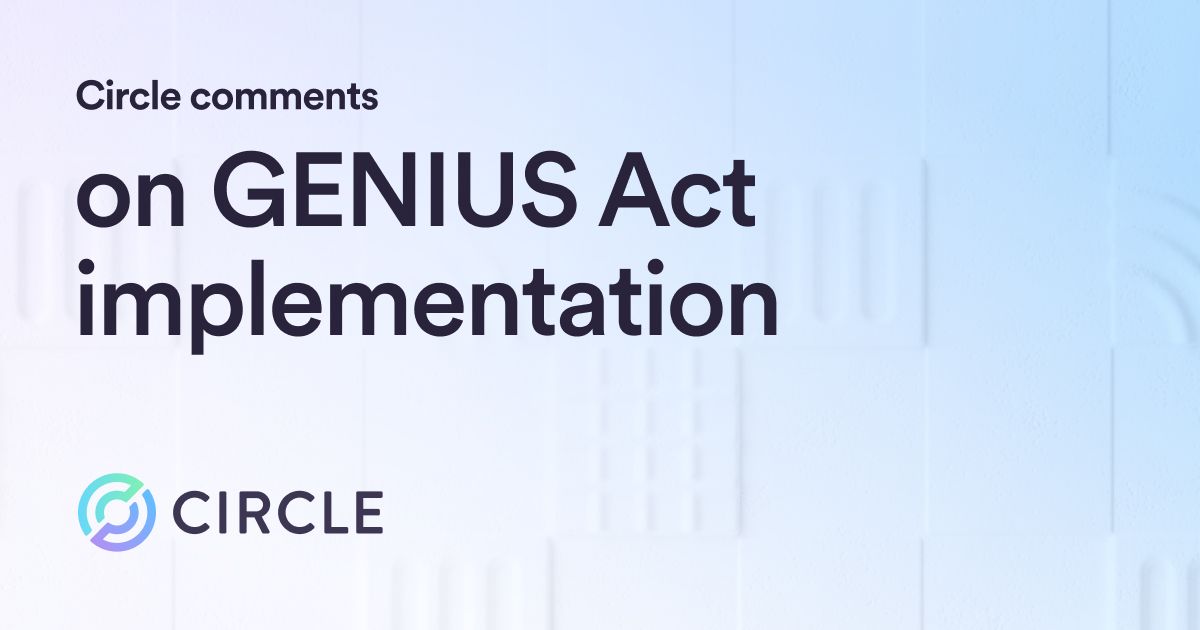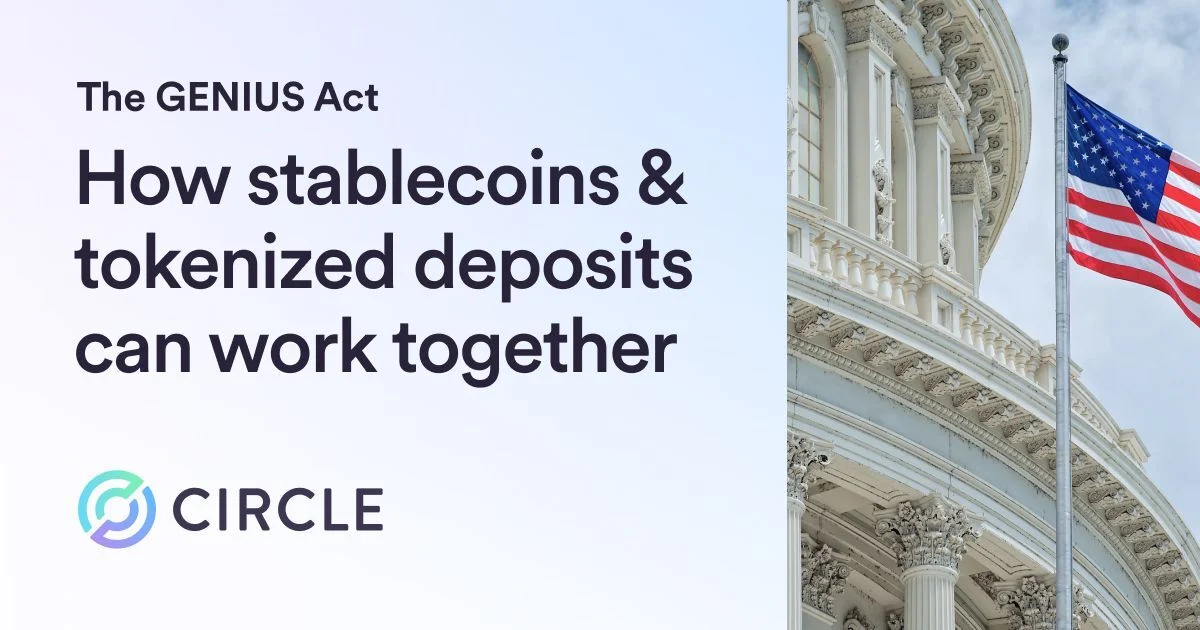Circle responds to Treasury’s Advance Notice of Proposed Rulemaking on the GENIUS Act and outlines recommendations to deliver a uniform, prudentially sound framework for U.S. dollar payment stablecoins.

On November 4, 2025, Circle submitted comments to the U.S. Department of the Treasury in response to its Advance Notice of Proposed Rulemaking on implementing the GENIUS Act. We welcome the opportunity to help Treasury operationalize a statute that does more than set guardrails for payment stablecoins—it lays groundwork for a federal digital payments framework in the United States. In our letter, we support full and faithful implementation of GENIUS to create a consistent national regime for permitted payment stablecoin issuers, regulated foreign payment stablecoin issuers, and the consumers who rely on them. Rulemaking should reinforce Congressional intent to make clear, robust rules of the road that support comprehensive compliance by all issuers that touch U.S. markets while giving Americans transparent, easy-to-understand financial products and services.
A cooperative supervisory approach across federal, state, and reciprocal regimes—grounded in uniform prudential, compliance, and risk management—can deliver national and global parity and preserve effective supervision. Implementation should also avoid unnecessary constraints that would impair liquidity management, cross-border payments, or interoperability with regulated financial infrastructure, and it should close evasion pathways so that all issuers leveraging the trust and stability of the U.S. dollar cannot sidestep the strong regime that Congress’ intended.
Circle’s high-level policy principles for GENIUS implementation:
- Protect customer funds with simple, strong rules. Every payment stablecoin should be fully backed with cash and high quality liquid assets, kept separate from company money, and redeemable at par, on demand. Independent monthly checks—and plain-English public reports—let people verify that their payment stablecoins are safe and that the backing assets are available when they need them, even if an issuer fails.
- Interoperability through reciprocity. Recognize foreign regimes that meet GENIUS standards and maintain effective, ongoing supervision—not registration-only or light-touch models. Criteria and determinations should be published.
- Same activity, same rules—no loopholes. If a digital token walks and talks like a dollar, it should have the same obligations as a payment stablecoin under the Act. Labels or marketing shouldn’t let anyone dodge safeguards. Rulemaking should ensure that any digital asset that is designed to offer stability and that everyday Americans can touch should meet the high standards set by Congress.
- Keep the playing field level at home and aligned abroad. Bank, nonbank, domestic, and foreign issuers should follow the same rules to protect consumers from bearing the risks of any regulatory shortcuts. Clear requirements for accessing U.S. markets—and shared supervision with trusted foreign regimes—promote competition while preventing offshore arbitrage.
- Set clear consequences and require “break-glass” plans. Penalties should be predictable for noncompliant actors, while good-faith efforts should be addressed through narrowly scoped safe-harbor protections. Issuers must maintain tested wind-down playbooks—so if something goes wrong, customers can get their money back quickly and fairly, including across borders.
GENIUS implementation is an opportunity to unify standards, raise transparency, and de-risk core payment functions without constraining innovation. By setting clear definitions, risk-sensitive prudential requirements, predictable enforcement, and a reciprocal path for compliant foreign issuers, Treasury can promote a safer, more competitive market that channels demand toward transparent, fully reserved, compliance-anchored products—reinforcing U.S. leadership in digital finance.
A summary of some key recommendations from Circle’s comment letter is below:
- Rulemaking should affirm that any digital asset that is designed to maintain a stable value in payments or that otherwise mimics features of compliant payment stablecoins under the Act should have the same obligations. Tokens that are fully backed but that deny a right to redemption, for example, should not evade oversight of the Act and expose unwitting consumers to harm.
- Capital and liquidity requirements should adequately take into account the risk profile of payment stablecoin issuance. Given the conservative composition of reserve assets, risk does not scale directly with circulation and depends disproportionately on operational, technology, and infrastructure risk. Fixed capital frameworks can perversely incentivize issuers to take risks with their operational functions and technology.
- All issuers—whether bank, nonbank, foreign, or domestic—should compete on a level playing field. This should be centered on the Act’s clear requirements that issuance be conducted out of a standalone issuer with the full resourcing, operational, and risk management capacity to meet the robust requirements of the Act.
- Treasury should issue guidance making clear how permitted U.S. stablecoin issuers can operate globally. Global utility of a payment stablecoin depends on interoperability with global financial institutions, and affirming Congressional intent to allow clear paths for fiat conversion around the world is an essential facet that will ensure that the growth of payment stablecoins continues to build strong partnerships between issuers and the broader banking system.
- Treasury should provide a safe harbor from liability for good faith compliance with lawful orders, enabling effective and timely enforcement and compliance without penalizing responsible cooperation. These safe harbor and other effective deterrence standards should then be promulgated internationally though bilateral, multilateral, and global standard setting initiatives.
- Insolvency and resolution requirements should be structured to facilitate international reciprocity using established cross-border principles to support orderly wind downs across borders and avoid dynamics that could cause a cross-border flight to safety.
- Rulemaking should support a regulatory accounting treatment of payment stablecoins issued by permitted issuers as cash and cash equivalents for accounting and tax purposes to promote consistent financial reporting and risk management in commerce, trade, and capital markets.
- The Act’s enforcement and penalties treatment should be clarified and aligned across the act and should take into account all risk transmission pathways that could affect U.S. consumers and financial markets. Ensuring effective, comparable supervision of all issuers is essential to protecting U.S. financial institutions and markets from illicit finance risk and unanticipated shocks.
- Comparability for foreign jurisdictions under the Act’s equivalence regime should ensure that a foreign jurisdiction maintain a well-resourced, ongoing, and effective supervisory and enforcement regime—not mere registration or a legal framework on paper—covering prudential, anti-money laundering, marketing, and other requirements in the same fashion as a U.S. issuer would face.
- Treasury and the Office of the Comptroller of the Currency should publish and maintain a public list of approved comparable jurisdictions and recognized foreign issuers, as well as evaluation criteria, in order to allow interoperability, market integrity, and transparency for issuers, intermediaries, and consumers alike.




